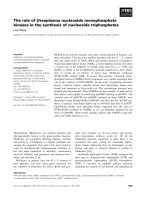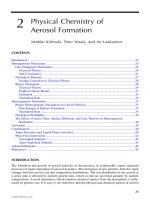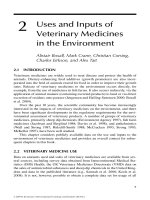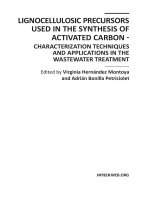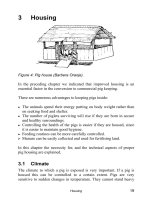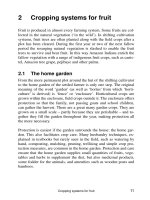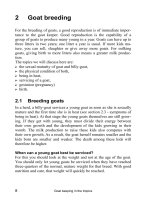Utilization of elemental sulfur in the synthesis of 2 aminobenzoxazoles
Bạn đang xem bản rút gọn của tài liệu. Xem và tải ngay bản đầy đủ của tài liệu tại đây (4.79 MB, 151 trang )
VIETNAM NATIONAL UNIVERSITY – HO CHI MINH CITY
HO CHI MINH CITY UNIVERSITY OF TECHNOLOGY
NGUYEN DUC THANH
UTILIZATION OF ELEMENTAL SULFUR
IN THE SYNTHESIS OF 2-AMINOBENZOXAZOLES
Major
: Chemical Engineering
Major Code
: 8520301
MASTER’S THESIS
HO CHI MINH CITY, July 2023
THIS THESIS IS COMPLETED AT
HO CHI MINH CITY UNIVERSITY OF TECHNOLOGY – VNU-HCM
Supervisors:
Dr. Nguyen Thanh Tung
Prof. Dr. Phan Thanh Son Nam
Examiner 1:
Dr. Dang Bao Trung
Examiner 2:
Dr. Tran Phuoc Nhat Uyen
This master’s thesis was defended at Ho Chi Minh City University of Technology –
VNU-HCM on 3rd July 2023.
Master’s Thesis Committee:
1. Chairman:
Assoc. Prof. Dr. Tran Hoang Phuong
2. Examiner 1: Dr. Dang Bao Trung
3. Examiner 2: Dr. Tran Phuoc Nhat Uyen
4. Secretary:
Dr. Nguyen Dang Khoa
5. Member:
Dr. Nguyen Thanh Tung
Approval of the Chairman of Master’s Thesis Committee and Dean of Faculty of
Chemical Engineering after the thesis being corrected (if any).
CHAIRMAN OF
THESIS COMMITTEE
Assoc. Prof. Dr. Tran Hoang Phuong
DEAN OF FACULTY OF
CHEMICAL ENGINEERING
VIETNAM NATIONAL UNIVERSITY – HO CHI MINH CITY
HO CHI MINH CITY UNIVERSITY OF TECHNOLOGY
SOCIALIST REPUBLIC OF VIETNAM
Independence – Freedom – Happiness
THE TASK SHEET OF MASTER’S THESIS
Full name: NGUYEN DUC THANH
Student ID: 2070486
Date of birth: 16/08/1998
Place of birth: Hanoi
Major: Chemical Engineering
Major ID: 8520301
I. THESIS TITLE:
In English: Utilization of elemental sulfur in the synthesis of 2-aminobenzoxazoles
In Vietnamese: Sử dụng lưu huỳnh nguyên tố trong tổng hợp các dẫn xuất dị vòng 2aminobenzoxazole
II. TASKS AND CONTENTS:
- Investigate novel transformation using o-nitrophenol, phenyl isothiocyanate, iron
salt, and elemental sulfur to synthesize the 2-aminobenzoxazole scaffold
- Optimize reaction conditions
- Study substrate scope and perform scale-up synthesis
- Study and propose reaction mechanisms
III. THESIS START DATE: 14/02/2022
IV. THESIS COMPLETION DATE: 01/05/2023
V. SUPERVISORS: Dr. Nguyen Thanh Tung
Prof. Dr. Phan Thanh Son Nam
Ho Chi Minh City, 12 June 2023
SUPERVISORS
Dr. Nguyen Thanh Tung
Prof. Dr. Phan Thanh Son Nam
HEAD OF DEPARTMENT
Dr. Nguyen Thanh Tung
DEAN OF FACULTY OF CHEMICAL ENGINEERING
ACKNOWLEDGEMENT
This thesis marks the final stage of my master’s program at the University of
Technology – VNU-HCM (HCMUT). Upon this moment, I have received considerable
guidance and assistance from various people and institutions. Therefore, I would like to
take this chance to express my gratitude to all the help during my study.
Firstly, I would like to thank HCMUT for providing me with time and facilities to
conduct my research and finish my degree.
I would like to thank Dr. Nguyen Thanh Tung and Prof. Dr. Phan Thanh Son Nam,
my supervisors, for their invaluable instructions and guidance when writing this thesis
and the research manuscript. I would also thank lecturers of Faculty of Chemical
Engineering, who have provided me with precious knowledge from their respective
fields and area of chemical engineering.
I would also like to acknowledge the help of my colleagues Huynh Nhat Tan, Tran
The Danh, and Ly Minh Thang. They have worked closely with me both in and out of
the lab and helped me speed up this project.
I would also like to express my thankfulness to Vingroup Innovation Foundation
(VinIF) for funding my study through a generous scholarship. The scholarship has
helped cover my tuition fee and other research-related expenses, which significantly
eased my mind and helped me focus on completing my study.
Finally, my sincere gratitude goes to my family and my girlfriend for
understanding and supporting me in pursuing postgraduate studies. Their unconditional
love and constant encouragement have always been my motivation through every
problem in my life.
Ho Chi Minh City, June 2023
Nguyen Duc Thanh
i
ABSTRACT
Utilization of o-nitrophenols to replace o-aminophenols in annulation reactions has
witnessed prominent attention over the last decade, as direct methods without a separate
reduction step were developed. These developments have been applied to synthesize
various 2-substituted benzoxazoles, yet they have been exorbitantly focused on
syntheses of carbon-substituted derivatives. Syntheses of 2-aminobenzoxazoles, an
important branch of 2-substituted benzoxazoles, still rely on o-aminophenols as the
building block. This research has filled this gap as I report direct annulations of onitrophenols with aryl isothiocyanates to furnish 2-aminobenzoxazoles. Reactions
proceeded in the presence of iron(III) acetylacetonate catalyst, elemental sulfur, NaOH
as a base, and DMSO as a solvent. Many derivatives of 2-aminobenzoxazoles bearing
nitro, trifluoromethyl, cyano, acetyl, sulfonyl, secondary amines, pyrrolyl, and
heteroaryl groups were obtained in moderate to good yields. Some of them were firstly
reported, which confirmed the wide applicability of this method. The mechanism was
shown to involve Fe/S cluster catalytic cycle, where elemental sulfur played both as a
component of the cluster and as an external reductant.
ii
TÓM TẮT
Việc sử dụng các dẫn xuất o-nitrophenol thay thế cho dẫn xuất o-aminophenol
tương ứng trong các phản ứng đóng vòng đã thu hút sự chú ý trong hơn một thập kỉ qua,
khi các phương pháp đóng vịng trực tiếp không thông qua phản ứng khử riêng biệt được
phát triển rộng rãi. Nhiều nghiên cứu đã tổng hợp thành công benzoxazole thế vị trí C2
bằng phương pháp mới nói trên, tuy nhiên họ quá chú trọng vào những nhóm thế gốc
carbon. Do đó, các phản ứng tổng hợp 2-aminobenzoxazole, một nhánh quan trọng của
benzoxazole thế vị trí C2, vẫn dựa vào các dẫn xuất o-aminophenol làm khung sườn sản
phẩm. Luận văn này đã khắc phục nhược điểm trên khi báo cáo hướng sử dụng các dẫn
xuất o-nitrophenol trong phản ứng đóng vịng với các dẫn xuất phenyl isothiocyanate để
tổng hợp khung sản phẩm 2-aminobenzoxazole. Phản ứng xảy ra trong điều kiện sử
dụng sắt(III) acetylacetonate làm xúc tác, lưu huỳnh nguyên tố, NaOH làm base và
DMSO làm dung môi. Nhiều dẫn xuất 2-arylaminobenzoxazole gắn những nhóm thế
như nitro, trifluoromethyl, cyano, acetyl, sulfonyl, amine bậc hai, pyrrolyl, hay dị vòng
thơm đều đã được tổng hợp thành công với hiệu suất từ trung bình đến tốt. Trong đó,
một số dẫn xuất được cơng bố lần đầu tiên, cho thấy phạm vi ứng dụng rộng của phương
pháp. Phản ứng được cho là đi qua cơ chế xúc tác của cụm nguyên tử Fe/S, trong đó lưu
huỳnh ngun tố tham gia với hai vai trị: vừa là thành phần tạo nên cụm nguyên tử Fe/S
trên, vừa là chất khử bổ sung cho phản ứng.
iii
DECLARATION OF AUTHORSHIP
I hereby declare that this thesis has been composed solely by myself, under
supervision of Dr. Nguyen Thanh Tung and Prof. Dr. Phan Thanh Son Nam, at
University of Technology – VNU-HCM. To the best of my knowledge, this thesis
contains no material previously published by any other person except where due
reference has been made. This thesis contains no material which has been accepted as
part of the requirements of any other academic degree or non-degree program, in English
or in any other language.
This is a true copy of the thesis, including final revisions.
Nguyen Duc Thanh
iv
TABLE OF CONTENTS
CHAPTER 1. LITERATURE REVIEW .....................................................................1
1.1. Elemental sulfur in the synthesis of heterocycles ................................................1
1.1.1. Elemental sulfur acting as a building block for heterocycles .......................1
1.1.2. Elemental sulfur acting as an oxidant .........................................................10
1.1.3. Elemental sulfur acting as a catalyst for non-redox reactions ....................12
1.1.4. Elemental sulfur acting as a catalyst for redox condensations ...................13
1.1.4.1. Elemental sulfur as lone catalyst .........................................................13
1.1.4.2. Elemental sulfur and a Fe source as co-catalysts ................................13
1.2. Synthesis of the 2-aminobenzoxazole scaffold ..................................................16
1.2.1. Introduction to 2-aminobenzoxazoles.........................................................16
1.2.2. Reported pathways for the synthesis of 2-aminobenzoxazoles ..................17
1.3. Research hypothesis ...........................................................................................21
1.4. Aims of research .................................................................................................21
CHAPTER 2. EXPERIMENTAL ..............................................................................22
2.1. Research objectives ............................................................................................22
2.2. Methodology ......................................................................................................22
2.3. Materials and Instrumentation............................................................................22
2.3.1. Materials .....................................................................................................22
2.3.2. Instrumentation ...........................................................................................25
2.4. Experimental procedure .....................................................................................26
2.4.1. Synthesis of various o-nitrophenols............................................................26
2.4.2. Optimization studies ...................................................................................29
2.4.2.1. Model reaction .....................................................................................29
v
2.4.2.2. Typical optimization experiments .......................................................30
2.4.3. General procedure for the syntheses of 2-aminobenzoxazoles ..................30
2.4.4. Scale-up synthesis of N-phenylbenzo[d]oxazol-2-amine (3aa)..................31
CHAPTER 3. RESULTS AND DISCUSSION ..........................................................32
3.1. Optimization studies...........................................................................................32
3.1.1. Model reaction ............................................................................................32
3.1.2. Effect of various Fe-based catalysts ...........................................................32
3.1.3. Effect of catalyst amount ............................................................................33
3.1.4. Effect of reaction temperature ....................................................................34
3.1.5. Effect of reactants molar ratio ....................................................................35
3.1.6. Effect of sulfur amount ...............................................................................37
3.1.7. Effect of various bases ................................................................................38
3.1.8. Effect of base amount .................................................................................39
3.1.9. Effect of various solvents ...........................................................................40
3.1.10. Effect of reaction duration ........................................................................41
3.2. Substrate scope and limitation ...........................................................................42
3.3. Mechanistic studies ............................................................................................50
3.3.1. Control experiments ....................................................................................50
3.3.2. Proposed mechanism ..................................................................................51
CHAPTER 4. CONCLUSION AND FUTURE REMARKS ...................................54
4.1. Conclusion ..........................................................................................................54
4.2. Future remarks ...................................................................................................54
LIST OF PUBLICATIONS.........................................................................................56
REFERENCES ............................................................................................................57
APPENDIX A. CALIBRATION CURVE .................................................................66
vi
APPENDIX B. GC-MS CHROMATOGRAM OF REACTION MIXTURE ........69
APPENDIX C. SPECTRAL DATA ............................................................................70
vii
LIST OF SCHEMES
Scheme 1.1. Synthesis of thiophenes from aryl acetaldehyde, 1,3-dicarbonyls, and S ..2
Scheme 1.2. Michael-Gewald reaction to synthesize 2-aminothiophenes ......................2
Scheme 1.3. Modified Gewald reaction to synthesize 2-aminothiophenes.....................3
Scheme 1.4. One-pot four-component synthesis of 2-aminothiophenes .........................3
Scheme 1.5. Sulfurative denitration synthesis of benzothiophenes ................................3
Scheme 1.6. Copper-catalyzed tandem cyclization synthesis of benzo[4,5]thieno[3,2d]thiazoles ........................................................................................................................4
Scheme 1.7. Metal-free tandem cyclization synthesis of benzo[4,5]thieno[3,2-d]thiazol2-amines...........................................................................................................................5
Scheme 1.8. Copper-mediated synthesis of benzo[4,5]thieno[2,3-d]thiazoles ...............5
Scheme 1.9. Synthesis of thiazoles..................................................................................6
Scheme 1.10. Synthetic pathways of benzothiazoles from o-iodoanilines .....................6
Scheme 1.11. Synthetic pathways of benzothiazoles from o-chloronitrobenzenes ........7
Scheme 1.12. Synthesis of benzisothiazoles from o-chloroarylamidines .......................8
Scheme 1.13. Iodonium-mediated synthesis of 1,2,3-thiadiazoles .................................8
Scheme 1.14. Synthetic pathways of 1,2,4-thiadiazoles .................................................9
Scheme 1.15. One-pot synthesis of 1,2,3,4-thiatriazoles ................................................9
Scheme 1.16. Synthesis of sultams from o-nitrochalcones .............................................9
Scheme 1.17. Willgerodt-Kindler-like synthesis of benzoxazoles ................................10
Scheme 1.18. Synthesis of quinoxaline-2-thiones from o-phenylenediamines ............ 11
Scheme 1.19. Synthesis of dibenzo[d,f][1,3]diazepines from 2,2’-diaminobiaryls ...... 11
Scheme 1.20. Synthesis of benzazoles from o-hydroxy/amino anilines and trihaloamides
.......................................................................................................................................12
viii
Scheme 1.21. Synthesis of 2-aminobenzoxazoles from o-aminophenols and aryl
isothiocyanates...............................................................................................................12
Scheme 1.22. Sulfur as lone catalyst for reductive annulations of o-nitrophenols .......13
Scheme 1.23. Synthetic pathways of benzazoles from o-hydroxy/amino/mercaptan
nitrobenzenes .................................................................................................................14
Scheme 1.24. Synthesis of 2-aminobenzoxazoles from phenolic thioureas .................18
Scheme 1.25. Two-step synthesis of 2-aminobenzoxazoles from o-aminophenols ......18
Scheme 1.26. Synthesis of 2-aminobenzoxazoles from thiourea, o-iodophenols, and aryl
iodides ............................................................................................................................19
Scheme
1.27.
Synthetic
pathways
for
2-arylamino
benzazoles
from
o-
hydroxy/mercaptan anilines...........................................................................................19
Scheme 1.28. Green synthetic pathways for 2-arylamino benzazoles from ohydroxy/mercaptan anilines...........................................................................................20
Scheme 1.29. Research hypothesis ................................................................................21
Scheme 2.1. Synthesis of 1f ..........................................................................................26
Scheme 2.2. Synthesis of 1i ...........................................................................................26
Scheme 2.3. Synthesis of 1k and 1l ...............................................................................27
Scheme 2.4. Synthesis of 1p..........................................................................................27
Scheme 2.5. Synthesis of 1j ..........................................................................................27
Scheme 2.6. Synthesis of 1m ........................................................................................28
Scheme 2.7. Synthesis of 1q..........................................................................................28
Scheme 2.8. Synthesis of 1r ..........................................................................................29
Scheme 2.9. Model reaction to test hypothesis feasibility ............................................29
Scheme 2.10. Optimization studies ...............................................................................30
Scheme 2.11. General procedure for substrate scope investigation ..............................30
Scheme 2.12. 1-mmol synthesis of 3aa .........................................................................31
ix
Scheme 3.1. Optimal set of conditions ..........................................................................42
Scheme 3.2. Control experiments ..................................................................................50
x
LIST OF FIGURES
Figure 1.1. Structure of Fe/S cluster and its ability to accept and release electrons, from
[42].................................................................................................................................15
Figure 1.2. General catalytic cycle of Fe/S cluster........................................................16
Figure 1.3. Some biologically active compounds with 2-aminobenzoxazole core .......17
Figure 3.1. Various Fe-based catalysts ..........................................................................33
Figure 3.2. Fe(acac)3 amount.........................................................................................34
Figure 3.3. Reaction temperature ..................................................................................35
Figure 3.4. Different molar ratios between 1a and 2a ...................................................36
Figure 3.5. Sulfur amount ..............................................................................................37
Figure 3.6. Various bases ...............................................................................................39
Figure 3.7. Base amount ................................................................................................40
Figure 3.8. Various solvents ..........................................................................................41
Figure 3.9. Reaction duration ........................................................................................42
Figure 3.10. Possible mechanism ..................................................................................52
Figure 3.11. Possible pathway from II to III ................................................................53
xi
LIST OF APPENDIX FIGURES
Figure Appendix A.1. Calibration curve of instrument 1 ..............................................67
Figure Appendix A.2. Calibration curve of instrument 2 ..............................................68
Figure Appendix B.1. Typical GC-MS chromatogram .................................................69
Figure Appendix C.1. 1H NMR spectrum of 3aa ..........................................................71
Figure Appendix C.2. 13C NMR spectrum of 3aa .........................................................71
Figure Appendix C.3. 1H NMR spectrum of 3ab ..........................................................73
Figure Appendix C.4. 13C NMR spectrum of 3ab .........................................................73
Figure Appendix C.5. 1H NMR spectrum of 3ac ..........................................................75
Figure Appendix C.6. 13C NMR spectrum of 3ac .........................................................75
Figure Appendix C.7. 1H NMR spectrum of 3ad ..........................................................77
Figure Appendix C.8. 13C NMR spectrum of 3ad .........................................................77
Figure Appendix C.9. 1H NMR spectrum of 3ae ..........................................................79
Figure Appendix C.10. 13C NMR spectrum of 3ae .......................................................79
Figure Appendix C.11. 19F NMR spectrum of 3ae ........................................................80
Figure Appendix C.12. 1H NMR spectrum of 3af .........................................................82
Figure Appendix C.13. 13C NMR spectrum of 3af........................................................82
Figure Appendix C.14. 19F NMR spectrum of 3af ........................................................83
Figure Appendix C.15. 1H NMR spectrum of 3ag ........................................................85
Figure Appendix C.16. 13C NMR spectrum of 3ag .......................................................85
Figure Appendix C.17. 19F NMR spectrum of 3ag .......................................................86
Figure Appendix C.18. 1H NMR spectrum of 3ah ........................................................88
Figure Appendix C.19. 13C NMR spectrum of 3ah .......................................................88
Figure Appendix C.20. 19F NMR spectrum of 3ah .......................................................89
xii
Figure Appendix C.21. 1H NMR spectrum of 3ai .........................................................91
Figure Appendix C.22. 13C NMR spectrum of 3ai ........................................................91
Figure Appendix C.23. HRMS spectrum of 3ai ............................................................92
Figure Appendix C.24. 1H NMR spectrum of 3ba ........................................................94
Figure Appendix C.25. 13C NMR spectrum of 3ba .......................................................94
Figure Appendix C.26. 1H NMR spectrum of 3ca ........................................................96
Figure Appendix C.27. 13C NMR spectrum of 3ca .......................................................96
Figure Appendix C.28. 1H NMR spectrum of 3da ........................................................98
Figure Appendix C.29. 13C NMR spectrum of 3da .......................................................98
Figure Appendix C.30. 19F NMR spectrum of 3da .......................................................99
Figure Appendix C.31. 1H NMR spectrum of 3ea ......................................................101
Figure Appendix C.32. 13C NMR spectrum of 3ea .....................................................101
Figure Appendix C.33. 1H NMR spectrum of 3fa .......................................................103
Figure Appendix C.34. 13C NMR spectrum of 3fa......................................................103
Figure Appendix C.35. 1H NMR spectrum of 3ga ......................................................105
Figure Appendix C.36. 13C NMR spectrum of 3ga .....................................................105
Figure Appendix C.37. HRMS spectrum of 3ga .........................................................106
Figure Appendix C.38. 1H NMR spectrum of 3ha ......................................................108
Figure Appendix C.39. 13C NMR spectrum of 3ha .....................................................108
Figure Appendix C.40. HRMS spectrum of 3ha .........................................................109
Figure Appendix C.41. 1H NMR spectrum of 3ia ....................................................... 111
Figure Appendix C.42. 13C NMR spectrum of 3ia ...................................................... 111
Figure Appendix C.43. HRMS spectrum of 3ia .......................................................... 112
Figure Appendix C.44. 1H NMR spectrum of 3ja ....................................................... 114
Figure Appendix C.45. 13C NMR spectrum of 3ja...................................................... 114
xiii
Figure Appendix C.46. HRMS spectrum of 3ja .......................................................... 115
Figure Appendix C.47. 1H NMR spectrum of 3ka ...................................................... 117
Figure Appendix C.48. 13C NMR spectrum of 3ka ..................................................... 117
Figure Appendix C.49. HRMS spectrum of 3ka ......................................................... 118
Figure Appendix C.50. 1H NMR spectrum of 3la .......................................................120
Figure Appendix C.51. 13C NMR spectrum of 3la ......................................................120
Figure Appendix C.52. HRMS spectrum of 3la ..........................................................121
Figure Appendix C.53. 1H NMR spectrum of 3ma .....................................................123
Figure Appendix C.54. 13C NMR spectrum of 3ma....................................................123
Figure Appendix C.55. HRMS spectrum of 3ma ........................................................124
Figure Appendix C.56. 1H NMR spectrum of 3na ......................................................126
Figure Appendix C.57. 13C NMR spectrum of 3na .....................................................126
Figure Appendix C.58. HRMS spectrum of 3na .........................................................127
Figure Appendix C.59. 1H NMR spectrum of 3oa ......................................................129
Figure Appendix C.60. 13C NMR spectrum of 3oa .....................................................129
xiv
LIST OF TABLES
Table 2.1. List of chemicals and their manufacturers ....................................................23
Table 3.1. Substrate scope .............................................................................................43
xv
LIST OF APPENDIX TABLES
Table Appendix A.1. Data for constructing calibration curves .....................................66
xvi
LIST OF ABBREVIATIONS
1,1-DPE
1,1-Diphenylethylene
acac
Acetylacetonate ion
CNS
Central nervous system
Cy
DABCO
Cyclohexyl group
1,4-Diazabicyclo[2.2.2]octane
DiPEA
Diisopropylethylamine
DMAP
4-Dimethylaminopyridine
DMF
N,N-dimethylformamide
DMSO
Dimethyl sulfoxide
EI
Electron ionization
ESI
Electrospray ionization
GC
Gas chromatography
GC-MS
Gas chromatography – Mass spectrometry
HRMS
High-resolution mass spectrometry
LC-MS
Liquid chromatography – Mass spectrometry
m.p.
Melting point
NMM
N-methylmorpholine
NMP
N-methylpiperidine
NMR
Nuclear magnetic resonance
rr
Regioisomeric ratio
r.t.
Room temperature
SNAr
Aromatic nucleophilic substitution
TBAB
tert-Butylammonium bromide
TBAI
tert-Butylammonium iodide
TBHP
tert-Butyl hydroperoxide
TLC
Thin-layer chromatography
TMS
Tetramethylsilane
VEGFR-2
Vascular Endothelial Growth Factor Receptor 2
xvii
NMR splitting patterns
s
singlet
d
doublet
t
triplet
q
quartet
dd
doublet of doublets
td
triplet of doublets
dt
doublet of triplets
tt
triplet of triplets
ddd
doublet of doublets of doublets
tdd
triplet of doublets of doublets
m
multiplet
xviii
CHAPTER 1. LITERATURE REVIEW
1.1. Elemental sulfur in the synthesis of heterocycles
Elemental sulfur is one of the most important materials in organic chemistry
recently. Although the element itself only constitutes 0.052 wt.% of the Earth’s crust,
sulfur in its elemental form is a readily available material with a production rate of more
than 70 million tons per year, as it is a by-product of modern oil and gas refineries [1,
2]. Elemental sulfur exists as a stable, non-volatile, non-hygroscopic, free-flowing
yellow solid; therefore, it is generally safe to work with sulfur [1]. These properties,
along with its cheapness and abundance, have made elemental sulfur a promising
reactant for organic chemists to explore [1].
Regarding reactivity, although elemental sulfur is not very reactive under ambient
conditions, its reactivity can be largely modified upon heating and/or addition of a base
or a transition metal ion [2]. Moreover, since sulfur shows a wide range of covalency
from two, four, to six, it can comfortably participate in cyclic structures. As a result,
elemental sulfur has been incorporated into a variety of organic reactions, especially in
the syntheses of heterocycles.
1.1.1. Elemental sulfur acting as a building block for heterocycles
As previously mentioned, the ability to form cyclic structures is an interesting
reactivity of elemental sulfur. Because of this, numerous sulfur-containing heterocycles
have been synthesized.
Thiophenes might be the most important sulfur-containing heterocycles.
Substituted thiophenes could be achieved from a reaction mixture of aryl acetaldehydes,
elemental sulfur, and 1,3-dicarbonyls, following a [2+2+1] cyclization (Scheme 1.1) [3].
Various functionalities were compatible with this transformation. Notably, the reaction
showed regioselectivity toward the less hindered carbonyl group when asymmetric 1,3dicarbonyls were employed.
1
Scheme 1.1. Synthesis of thiophenes from aryl acetaldehyde, 1,3-dicarbonyls, and S
2-Aminothiophene, a scaffold present in various pharmaceutical agents, was
successfully generated in Gewald reaction and its modifications [2]. In one example, the
Michael-Gewald modification used a Michael addition between indoles or pyrrole and
acroleins to generate the carbonyl component, which was subsequently consumed in a
Gewald-like reaction with acetonitriles and elemental sulfur to produce highly
substituted 2-aminothiophenes (Scheme 1.2) [4].
Scheme 1.2. Michael-Gewald reaction to synthesize 2-aminothiophenes
The use of Michael addition reactions prior to forming 2-aminothiophenes could
serve to diversify the molecular complexity of such valuable biologically active
scaffold. However, this method suffered an unexpected side reaction when malononitrile
was used as the acetonitrile derivative. A different approach to diversify the scope of
Gewald-like reactions was reported by Kavitha et al., where the carbonyl component
was replaced by a benzylidenemalononitrile, a condensation product of an aldehyde and
malononitrile (Scheme 1.3). More interestingly, the authors also reported a direct four-
2
component version of this transformation, using L-proline as the catalyst (Scheme 1.4).
It was also noted that both versions of this transformation comfortably progressed at
room temperature [5].
Scheme 1.3. Modified Gewald reaction to synthesize 2-aminothiophenes
Scheme 1.4. One-pot four-component synthesis of 2-aminothiophenes
Benzo-fused thiophenes were another important structure of sulfur-containing
heterocycles. Nguyen et al. reported a sulfurative denitration and cyclization of onitrochalcones to produce the benzothiophene structure (Scheme 1.5) [6]. This
transformation tolerated many functional groups but required an ortho nitro group to
proceed. Mechanistic studies revealed that elemental sulfur was activated by strong
bases, such as DiPEA or other tertiary amines, to serve as an active reactant.
Scheme 1.5. Sulfurative denitration synthesis of benzothiophenes
3
More complicated benzothiophene structures were also synthesized. Huang et al.
reported a bis-heteroannulation reaction to generate the benzo[4,5]thieno[3,2-d]thiazole
structure from acetophenone oximes, aryl aldehydes, and elemental sulfur in the
presence of copper(I) salt (Scheme 1.6) [7].
Scheme 1.6. Copper-catalyzed tandem cyclization synthesis of benzo[4,5]thieno[3,2d]thiazoles
In another publication, these authors also reported a metal-free approach to
synthesize the same structure, albeit with an arylamino substituent instead of aryl group
(Scheme 1.7) [8]. Mechanistically, it was suggested that 3-aminobenzothiophene could
be the intermediate, which underwent an o-sulfuration upon heating to produce the oaminothiophenol-like structure and then reacted with the C1-synthon with the aid of
elemental sulfur to furnish the desired structure [7, 8]. In both examples, elemental
sulfur was activated either by a transition metal ion or by a base. Since both methods
involved formation of a C-S bond adjacent to the original oxime group, metasubstituents on the oxime ring would inevitably produce pairs of isomers, of which the
5-substituted products were more favorable.
4


